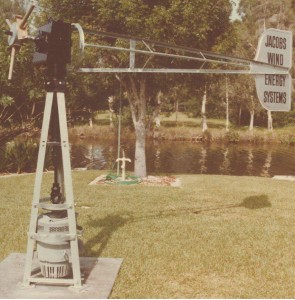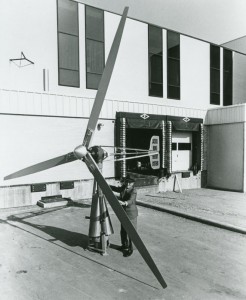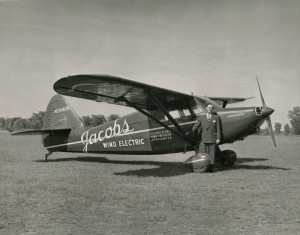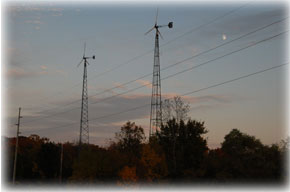Second Iteration
The Energy Crisis and Return of Jacobs Wind Electric:
Third Generation Design (1974-1985)
The 1960s came and went with little talk of wind energy. While the concept of wind energy lived on the overall technology, by some accounts, actually took a step back during this time period.
Alternative energies were thrust into the spotlight once more in the 1970s. Turmoil over new energies, such as nuclear power, and the harmful effects of coal power bolstered the ranks of environmentalists. They looked to other means of energy production.
The real policy changing catalyst, however, came in the form of the 1973 OPEC oil embargo. As with many changes in history, it took the push of upsetting the status quo, in this case, of the energy market. Quadrupling the price of oil was just that push.
Wind energy now had a new role. While it had been used as a sole provider of electricity where there was otherwise none (off-grid use) it was now looked at as a way of tying into and supplementing the existing infrastructure, or on-grid use. This is the direction that Jacobs Wind went – a system that could power a household and add energy to the grid in times of good wind, but could also use utility resources when gusts were poor.
A New Company and a New Design for the 80s
Working out of Ft. Myers, FL, M.L. re-entered the no longer dormant wind business. Unfortunately, his brother Joe, who died in a car accident in 1963, would not be around to see wind energy return. Marcellus enlisted the help of his son, Paul R. Jacobs, and together they went back to designing a new wind machine much as he and his brother had done over 40 years earlier. In 1974 the second Jacobs Wind firm was founded by M.L. and Paul in Florida. Research was done, patents were filed, and development began.
Many of the same principles used in earlier Jacobs designs carried through, but the power output had to be increased to accommodate the load required for modern households. The old 2.5 and 3kW systems would not suffice, so a new 10kW design was conceived. The new model was a result of refinement of the old. What worked was examined, what could be improved was upgraded, and everything was brought in line with the times. One of the most overt mechanical changes came in the switch from a direct drive generator to a gearbox transferring power to the generator which was now housed in the tower, a factory assembled and tested stub assembly.
By March of 1979, four demo units of the 3rd generation Jacobs design were in existence. The new machines, coupled with the history of the Jacobs name and Marcellus Jacobs’ recent media recognition, drew attention and in no short time interested investors were found. In March of that same year, the Control Data Corporation (CDC) and Jacobs Wind Electric Co. Inc (JWEI) entered into agreements to buy three demo systems and cooperatively build 10 more using the most recent Jacobs Wind design.
As a result of this agreement, a joint venture company was formed between JWEI Florida and CDC in 1980. It became the Jacobs Wind Electric Company a Delaware corporation (JWE). This jointly owned company served as the business front for the two companies, while M.L. and Paul managed it, (retaining their creative and intellectual autonomy as JWEI Florida). Between 1975 and 1985, 10 U.S. Patents for the new design were issued. These patents, as of 1980, were assigned to Jacobs Wind Deleware
Earth Energy Systems Inc. and a Separation of Intent
In 1985, JWEI Delaware became Earth Energy Systems Inc. (EESI). This was done after acquiring subsidiaries that built its generators, engines, and windfarms. By this point in time, M.L. and Paul had already begun to distance themselves from the actions and practices of CDC and EESI.
They had voiced concerns over the lack of field testing and the push for production without proper reworking to improve the design. This was viewed by them as a departure from what the original Jacobs name had stood for. Former methods of testing were replaced by computer models and engineering theory, which while viable, were relied on too heavily. This resulted in design flaws going into production.
The Loss of a Pioneer
These issues were never fully resolved. On July 15, 1985 M.L. Jacobs died as a result of injuries suffered in an automobile accident. At the age of 82 he had played an integral part in the beginning and rise of wind energy, and moved it along even further during its second big wave. Marcellus, outspoken and honest with his opinions, brought both admiration and scorn during his lifetime. His story inspired those entering the industry, while his blunt language rubbed some the wrong way. Some engineers especially did not appreciate being told they didn’t know what they were doing by a man who held no formal degree. The reputation of his machine spoke for itself and Marcellus was not shy in saying so.
Regardless of popularity, Marcellus Jacobs held 24 patents for wind systems, tidal energy-powered flushing of waterways, other marine products, and more. M.L. was a charter member of the National Association of Corrosion Engineers. He was also a founding member of the American Wind Energy Association. He continued working on his designs up until the time of his death. He was traveling on business, when he was struck by a car. Among his other accomplishments, M.L. was a member of two aviation pioneer groups: the OX5 Association in the U.S. and the Santos Dumont Foundation in Brazil.
The Second Decline of Wind Energy
The energy crisis of the 1970s & 80s was ending by 1985 with oil prices dropping back towards their former levels. By 1986 EESI ceased manufacturing. The company was dismantled by CDC. Wind Turbine Industries Corporation (WTIC) acquired the remaining inventory of Jacobs 20 kW machines and the license to sell that inventory. Over 300 10 kW and 1,200 17 to 20 kW units had been manufactured and sold by this point. The sub assemblies and component parts for hundreds more remaining in EESI warehouses were transferred in 1986 to WTIC.
Alternative energies after the 1980s went the way of a passing fad for many. The unsold EESI inventory, now in the hands of both WTIC and Jacobs Wind, met the weak market demand for small wind systems into this century. At Jacobs Wind, research, development and some custom production did continue. It is during this time that Jacobs Wind focused on gathering together those who still had an interest in and used small wind. A related wind system owners’ cooperative was launched in 1993 to focus on the long period of product life after the expiration of new product warranties.
Known by its initials, REPCO, Rural Energy Producers Electric Power Cooperative, is staffed by former employees of M. L.’s firms and other former CDC employees, The continual refinement of the Jacobs machine designs is still carried on at Paul’s residence, the former EESI test site in Corcoran, MN. Continuing to run the two small wind systems (17.5 and 20 kW) on their towers for decades, this and other REPCO sites maintain essence of what Jacobs Wind has always advocated: the benefits of ownership and operation of small or consumer sized wind generation plants, distributed widely over the existing grids of rural and exurban communities. Sited this way to use the uniformly available wind resource, there is no “new transmission” controversy and minimal new public infrastructure needed.
« Original Company | Additional Info »
Intro | Beginnings | Original Company | Second Iteration | Additional Info | Sources



